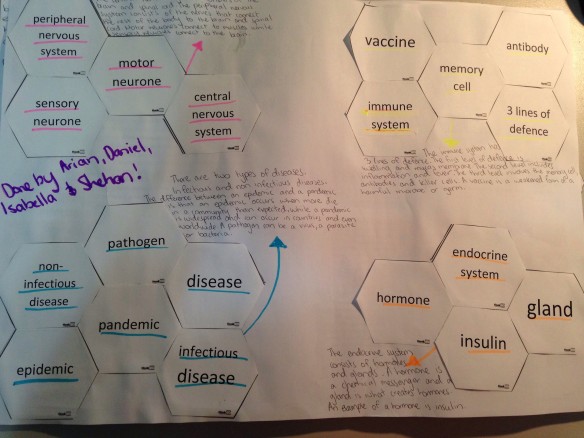Formative assessment is something I’ve been putting a lot more emphasis on over the past few years. I’m so sick of just relying of end-of-topic exams to gauge what students have learnt. I want my students to continuously question how they are going and make changes to their learning accordingly. This is one of the reasons that my faculty has embarked on a Structured Observed Learning Outcomes (SOLO) journey this year. One of the ways that many teachers using SOLO use to assess student learning is with SOLO hexagons.
SOLO hexagons involves the major concepts or ideas from a topic to be placed individually onto hexagons. Students then work individually or in groups to connect the hexagon concepts together and they must justify why they have made these connections. It is the justification where both the teacher and the student can assess the student’s learning. It is how students have connected the hexagons and their justification of WHY they have done it that way that allows their learning and thinking to then be assessed using the SOLO taxonomy (or not; the hexagon activity still works with no understanding of SOLO).
Here’s a video showing one way of using the SOLO hexagons in a UK science class.
Here’s an explanation of how to use SOLO hexagons from the SOLO guru, Pam Hooke.
I changed the hexagon activity slightly to suit the needs of my students. The picture shows the instructions that my students received.
And here are the hexagons my students used (note that the hexagons were pre-cut for students and placed into zip lock bags with the above instruction card). My students worked in groups of 2 to 4. I used the SOLO hexagon generator to create the hexagons.
Here’s some samples of the hexagons my students made.
Some things I noticed was that:
- My students were all fantastic at explaining each hexagon concept
- Some groups connected all the nervous system concepts and the endocrine system concepts together, showing they had an understanding that the nervous system and endocrine system worked together. However all the groups had the immune system concepts separate altogether. I did spend a lot of class time making it explicit that the nervous system and the endocrine system work together to control and coordinate the body. And while the students’ project was to make a fact sheet about how a particular disease/health issue affected the nervous system and the endocrine system, they seem to think that the immune system works on its own and is completely separate from the other systems.
From this activity we discussed their SOLO levels of understanding and how they can use their hexagon connections to see whether they were at a unistructural level, multistructural level, relational level or extended abstract level. Most students concluded they were at a relational level for most concepts and some thought they were extended abstract for some parts of the topic.
The SOLO hexagon activity is definitely something I will use again with my students. Now that they have done it once, the next time will run even better. Feedback from students was that they enjoyed talking about science with each other and that they learnt a lot from each other just by listening to what others had to say about each concept.
















